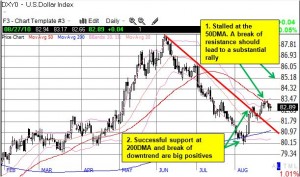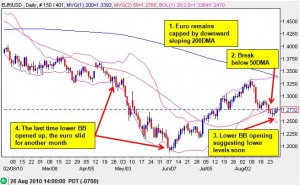The U.S. dollar index has made little progress since its tremendous one-day rally over two weeks ago. Over the past week, the dollar index has stalled out right at its 50-day moving average (DMA).

[Click for larger view]
*Chart created using TeleChart:

I set my plan at this point to dial my positions to net neutral on the dollar. However, I remain slightly dollar-positive thanks to my increasingly bearish opinion on the euro.
First, the dollar. The dollar’s churn seems driven by market indecision over the dollar’s status as a safe haven from a global economic slowdown and deflationary spiral or the tragic currency of a nation setting up to be a global laggard. None of the economic data this week resolved the impasse. Next Friday’s jobs report will deliver the next critical flashpoint.
Now, the euro. I almost failed to notice the euro’s steady deterioration this week given my focus on managing around the short EUR/USD position. The euro is scraping multi-year to all-time lows versus almost every other major currency. It should only be a matter of time before the euro finally succumbs to a retest of recent lows against the dollar.
The euro started the week marginally breaking below the 50DMA versus the U.S. dollar, but it has held its ground since then. The 200DMA also remains sloped downward. Both features make sense since the euro is the majority (58%) of the U.S. dollar index. However, the lower Bollinger Band has opened wide, suggesting a substantial move lower sooner than later.

[Click for larger view]
Source: dailyfx.com charts
The bond markets in Europe are giving the “go-ahead” for additional weakness in the euro. Spreads on Irish, Greek, and Portuguese bonds are widening again and the pangs of worry over defaults are re-awakening. In fact, “average spreads between German and peripheral country bonds are back in territory last seen in June and heading north.” Greece is right back where it was in May. Moreover, recent economic data out of Spain shows the situation there is worsening with a notable portion of debt-funded stimulus programs going into demand for German exports instead of domestic output.
I expect that once the European summer holiday ends, selling in the euro should accelerate – all else remaining equal of course.
Be careful out there!
Full disclosure: short EUR/USD, long EWP put
